The M.C.L Design Blog
An Interview with MCL Design Founder, CEO & Designer, Matthew Campbell Laurenza
Interviewer: Matthew, you wear so many hats and are so prolific with your work, can you give us a quick overview of all that you do?
Matthew: My full body of work encompasses sculpture, painting, objets d’arts, fine jewelry and industrial design, all reflective of the cumulative experience from my extensive and continuing travels. The fluidity to my designs maps my journeys across the planet, and expresses my profound interest in history, culture, architecture and the natural world, as an encyclopedic chronicle of my life experience. In outputting my unique and distinctive designs, I insist on intricate handcrafting and stringent quality of finish, as well as both ethical sourcing and production.
Interviewer: We understand you have a love of tradition and authentic craft, tell us about this.
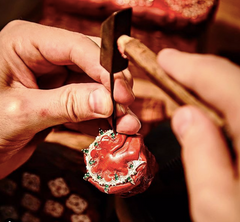 Matthew: With global industry increasingly dominated by automation and technology, I still recognize and greatly value sustainability of authentic craft. The very nature of craftsmanship, in the face global industry and technological trends, gives cause for concern over its sustainability. The threats to the practice of skilled artisanal works, despite seeing resurgence in popularity, in recent times, are still looming. Initially, as a fine arts graduate and bench jeweler, I began with the crafting of fine jewelry, as wearable art and sculpture, which is what brought about MCL Design. Yet, my love of the decorative arts brought me into handcrafting precious sculpture, objets, industrial design and lighting, as a natural extension of my abilities, training and passion.
Matthew: With global industry increasingly dominated by automation and technology, I still recognize and greatly value sustainability of authentic craft. The very nature of craftsmanship, in the face global industry and technological trends, gives cause for concern over its sustainability. The threats to the practice of skilled artisanal works, despite seeing resurgence in popularity, in recent times, are still looming. Initially, as a fine arts graduate and bench jeweler, I began with the crafting of fine jewelry, as wearable art and sculpture, which is what brought about MCL Design. Yet, my love of the decorative arts brought me into handcrafting precious sculpture, objets, industrial design and lighting, as a natural extension of my abilities, training and passion.
Interviewer: How do you manage all that you do professionally, whilst maintaining this emphasis on traditional work by hand?
 Matthew: Running a business for over 20 years, and maintaining an in-house workshop, within my studio, I place the utmost emphasis on preserving traditional craft, using no computer generation of images, and paying a fair wage, for skilled workers.
Matthew: Running a business for over 20 years, and maintaining an in-house workshop, within my studio, I place the utmost emphasis on preserving traditional craft, using no computer generation of images, and paying a fair wage, for skilled workers.
Interviewer: So, where does your inspiration come from?
Matthew: Living between the United States and Thailand, an interfusion of Asian and western cultures converses through my works. I derive inspiration from my life experiences and the rich blend of cultures and history I discover along my continual travels around the globe. Travel has one of the most profound impacts on my work; my understanding of color has most certainly been influenced through my extensive travels in Asia alone. Undertaking the creative process in the heart of Bangkok also injects a raw energy into my work, and I feel a grand affinity with the organized chaos of daily life there. These are just two of the many reasons this city has become my second home.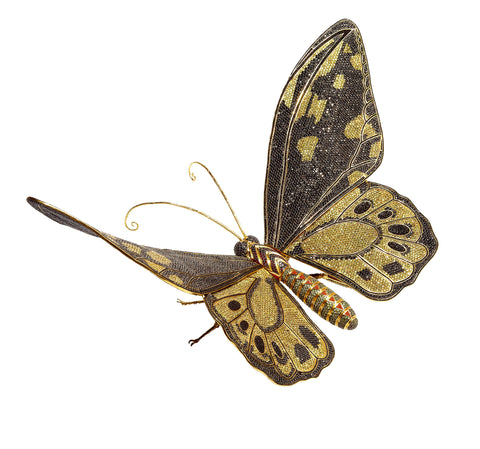
Interviewer: How do you stay fresh and inspired, even after 20 years in business?
Matthew: I am constantly innovating and evolving my personal design style, gathering creative inspiration from every aspect of life, particularly the natural world, its delicate, balance and our place within it. Through my craft, my mission is to make powerful statements, trigger reflection and inspire conversation. Threads, which connect all of my works, are the patterns, movements, lines, creatures and foliage of the natural world, from the tiniest minutiae to grand, imposing figures. I study their details and they feature heavily in my works. From the avian forms in my grand sculptures, the skyscapes of my abstract paintings, to flora and fauna in my jeweled sculptural wearable art and objets. With my passion for creating distinct pieces, I strive to make an impact and share my messages.
 Interviewer: Are there any influences on your works that you can allude to?
Interviewer: Are there any influences on your works that you can allude to?
Matthew: My creative inspiration is equally gathered from my fascination with the arts of many different eras past. Ranging from classic Chinese antiquities to elaborate Renaissance motifs, and eclectic Art Deco style to grand Gothic structures, I blend these strong influences with modern and quirky nuances to develop opulent designs.
Interviewer: How do you compete and maintain such high quality standards, amidst such fast-moving design and fashion industries, dominated by computers and automated machinery?
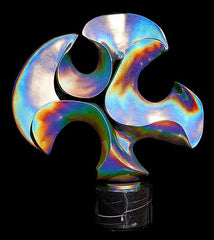 Matthew: My intensive, and most often lengthy, design process ensures exceptional quality that rivals top-tier luxury labels. Choosing ‘slow’ craftsmanship over today’s ‘fast fashion’ is a calling for me. As a trained craftsman myself, I fully appreciate the intensive human-hours, patience and precision, required by each of the craftsmen and –women I employee in my studio, to assist with handmaking my designs. Each piece, carved and sculpted by hand, bears the story of this craftsmanship, the legacy of tradition and a uniqueness, unrivalled by automation. There is a definite sense of pride in the work everyone in my studio feels. My stance on the need for sustainability in craftsmanship is perfectly summed up in my three-worded personal mantra: ‘cherishable, not perishable’. A meticulous craftsmanship is, therefore, one of the feature hallmarks of my works, which are often blended with precious and semi-precious stones, resulting in enviable and opulent articulations of my creative soul.
Matthew: My intensive, and most often lengthy, design process ensures exceptional quality that rivals top-tier luxury labels. Choosing ‘slow’ craftsmanship over today’s ‘fast fashion’ is a calling for me. As a trained craftsman myself, I fully appreciate the intensive human-hours, patience and precision, required by each of the craftsmen and –women I employee in my studio, to assist with handmaking my designs. Each piece, carved and sculpted by hand, bears the story of this craftsmanship, the legacy of tradition and a uniqueness, unrivalled by automation. There is a definite sense of pride in the work everyone in my studio feels. My stance on the need for sustainability in craftsmanship is perfectly summed up in my three-worded personal mantra: ‘cherishable, not perishable’. A meticulous craftsmanship is, therefore, one of the feature hallmarks of my works, which are often blended with precious and semi-precious stones, resulting in enviable and opulent articulations of my creative soul.
 Interviewer: What materials do you generally work with?
Interviewer: What materials do you generally work with?
Matthew: Given my sources of inspiration and taking an exuberant and artful approach to design, I have worked extensively in ceramics, stone, reclaimed metals and woods, often adorned with precious and semi-precious stones, to conjure up three-dimensional, visual expressions from deep within.
Interviewer: How do all your works come together, on a practical level?
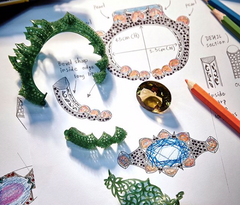 Matthew: The first stage of much of my design, such as with fine jewelry, objets and industrial design, takes place in my old-school, paper-and-pencil sketchbook, where I translate my inspirations into preliminary drawings. The designs are tweaked to perfection, before actual prototypes are executed; no computer-generated images or forms are used in the creation of any of my work. Often, during large-scale sculptural practices, I allow my subconscious to fully take control, when carving organically from the block; the block will become whatever it is meant to be. Whereas sculpture evolves by subtracting mass, in painting, I add to the void, with a visual expression of the heart, in progressive layers, until the finished work emerges. There, my multi-dimensional ideas are voiced on a flat, but stratified plain
Matthew: The first stage of much of my design, such as with fine jewelry, objets and industrial design, takes place in my old-school, paper-and-pencil sketchbook, where I translate my inspirations into preliminary drawings. The designs are tweaked to perfection, before actual prototypes are executed; no computer-generated images or forms are used in the creation of any of my work. Often, during large-scale sculptural practices, I allow my subconscious to fully take control, when carving organically from the block; the block will become whatever it is meant to be. Whereas sculpture evolves by subtracting mass, in painting, I add to the void, with a visual expression of the heart, in progressive layers, until the finished work emerges. There, my multi-dimensional ideas are voiced on a flat, but stratified plain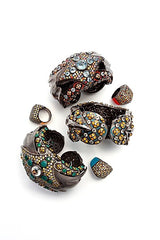
Interviewer: What about your jewelry design?
Matthew: Every stage of my fine jewelry design and production is art: the carving of the wax, the placement of stones, the use of color and texture, and the profile, so the premise is the same - it just happens to be wearable. So, all of these elements conspire, to create a miniature sculpture or work or art, if you will, to be worn and become part of someone’s daily life and a powerful expression of their personal style.
Interviewer: Returning to the quality of your work, you're a very meticulous person, how does your busy schedule allow you to remain so focused?
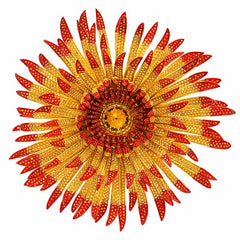 Matthew: Quality and production measures are extremely stringent for each piece I design and create. For my pieces, colorful natural stones are sourced, selected and combined, from around the world, for each design. All rough stones are chosen by certified staff and shaped by the finest stonecutters, to ensure optimum clarity and beauty. The provenance of stones offers nuance in each design, whether in surface texture or color gradient, to provide a unique identity. I take great care in choosing each stone to perfectly match the desired aesthetic for the placement in each piece. I strictly forbid the use of adhesive products to glue stones in place, and only implement hand-setting. This labor-intensive technique not only provides secure setting for every stone, but also results in better texture and more vibrant sparkle. The result is intricately handcrafted wearable art for vivid self-expression of identity, emotion and spirit. Meticulousness is key to ensuring that.
Matthew: Quality and production measures are extremely stringent for each piece I design and create. For my pieces, colorful natural stones are sourced, selected and combined, from around the world, for each design. All rough stones are chosen by certified staff and shaped by the finest stonecutters, to ensure optimum clarity and beauty. The provenance of stones offers nuance in each design, whether in surface texture or color gradient, to provide a unique identity. I take great care in choosing each stone to perfectly match the desired aesthetic for the placement in each piece. I strictly forbid the use of adhesive products to glue stones in place, and only implement hand-setting. This labor-intensive technique not only provides secure setting for every stone, but also results in better texture and more vibrant sparkle. The result is intricately handcrafted wearable art for vivid self-expression of identity, emotion and spirit. Meticulousness is key to ensuring that.
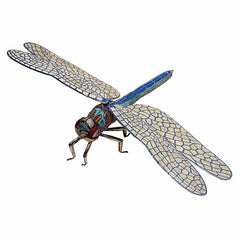 Interviewer: Tell us a little about your 'objets'?
Interviewer: Tell us a little about your 'objets'?
Matthew: My objets d’arts are bespoke, handcrafted art objects, set with gemstones, receiving treatment similar to that of my fine jewelry design. Constantly on display, an objet d'art for me requires opulent nuance and exquisite design. Drawing from my design disciplines of sculpture and jewelry, I often adorn these pieces with precious and semi-precious gemstones too, as well as apply intricate detailing.
Interviewer: Preserving craftsmanship is obviously very important to you. How did you become such an advocate for this?
Matthew: In times of fast fashion and mass production, the threat to traditional handcraft, by seasoned artisans, is real. With the fear of extinction and a loss of jobs to mechanized production, it is vital to realize the implications of this worrying trend, and endeavor to ensure its reversal. I view traditional craftsmanship as a cultural and design legacy, which is often passed down from generation to generation, requiring lengthy apprentice and high skill. As industry lurches ever forward with automated production, this cultural heritage, with its techniques, intrinsic historic value and unique skills, is in danger of being lost, should efforts not be made to sustain, revive and allow this legacy to survive. Sculpting all of my designs by hand also ensures that each item is ethically produced and characteristically unique, unlike mass production, which is such a burden on our planet. Mass production often equates to disposable fashion and accessories. The result of true craftsmanship is timeless design. 'Cherishable, not perishable'.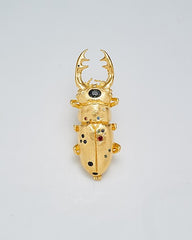
Interviewer: You touched upon ethical and environmentally-friendly design. Could you elaborate on this further?
Matthew: Absolutely. I endeavor to establish relationships with craftspeople and material suppliers, across the globe, who share my concerns for quality, integrity and the sustainability of my craft. In addition, as I mentioned earlier, I provide a fair wage for skilled artisans: this ensures their livelihoods, allowing this precious resource, in the creation of art and design, not to be lost or abandoned, in the passage of time. By focusing on preserving craftsmanship and ethical design, I pride myself on a more environmentally-friendly approach to the whole process. Pieces are produced in small batches, if not one-off, which ensures the unique identity of handmade pieces and a bespoke attention to detail. I am able to focus on the ethical treatment of people, and sustaining respect for artisanal skill, and on a responsible use of resources. By steering clear of mass production and automation, in my handcrafting approach to design, I also opt, where possible, for repurposing, recycling and reclaiming components.
Interviewer: You seem to have a strong sense of social responsibility, and you are often involved in charitable initiatives, how do you find the time?
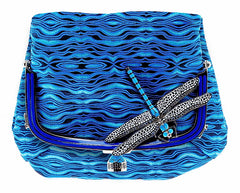 Matthew: As part of this sense of social responsibility I have, giving back is also an essential and integral component of conducting business and sharing my designs. Everyone, who is capable, should feel the desire to pay it forward and make time for that. I just happen to be very passionate about charity partnerships and collaborations, to raise funds for a variety of worthy causes, by participating in and contributing to a multitude of charity events and organizations every year. I'm always open to new ideas and opportunities for such collaborations. We make time for the things that are important to us.
Matthew: As part of this sense of social responsibility I have, giving back is also an essential and integral component of conducting business and sharing my designs. Everyone, who is capable, should feel the desire to pay it forward and make time for that. I just happen to be very passionate about charity partnerships and collaborations, to raise funds for a variety of worthy causes, by participating in and contributing to a multitude of charity events and organizations every year. I'm always open to new ideas and opportunities for such collaborations. We make time for the things that are important to us.



